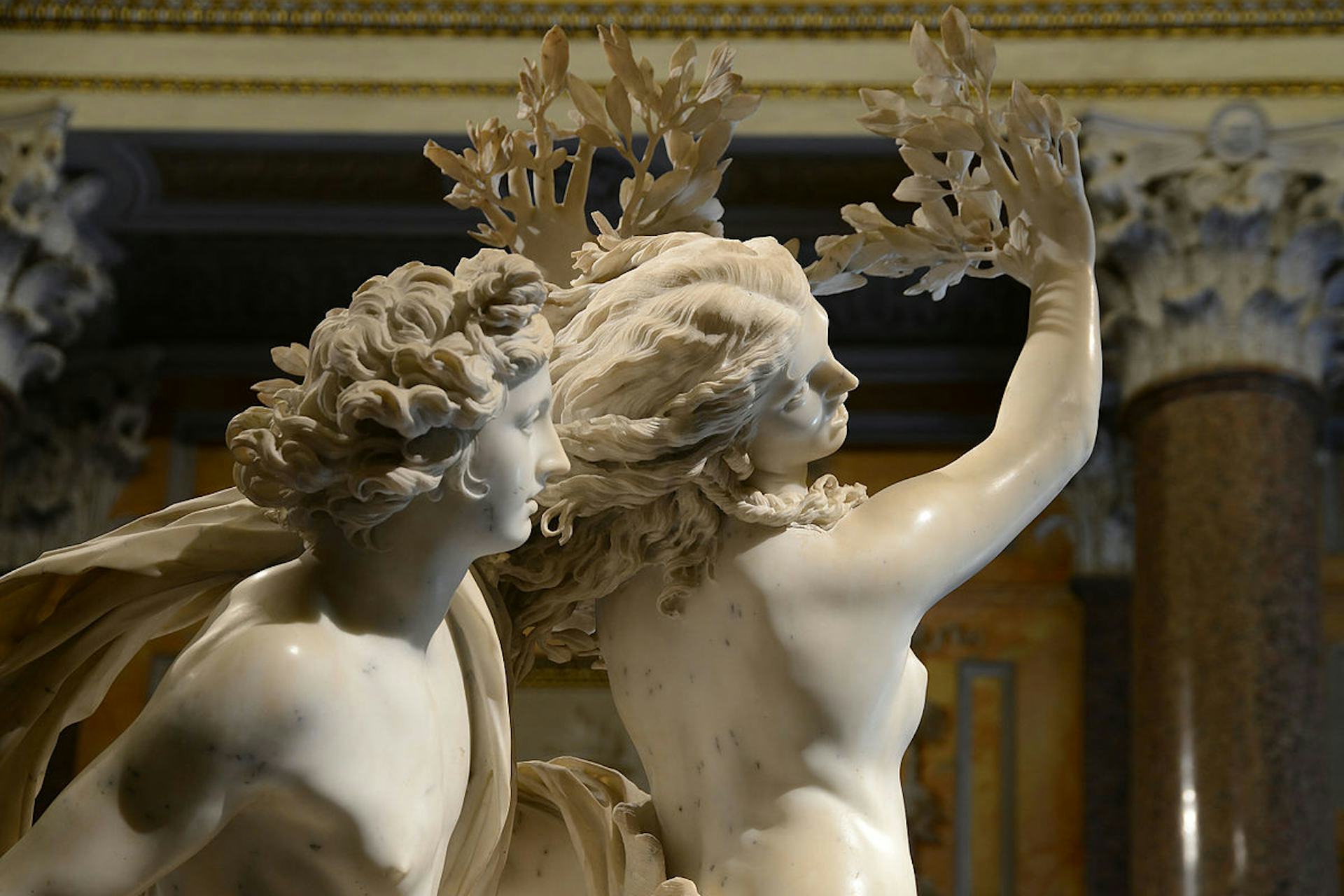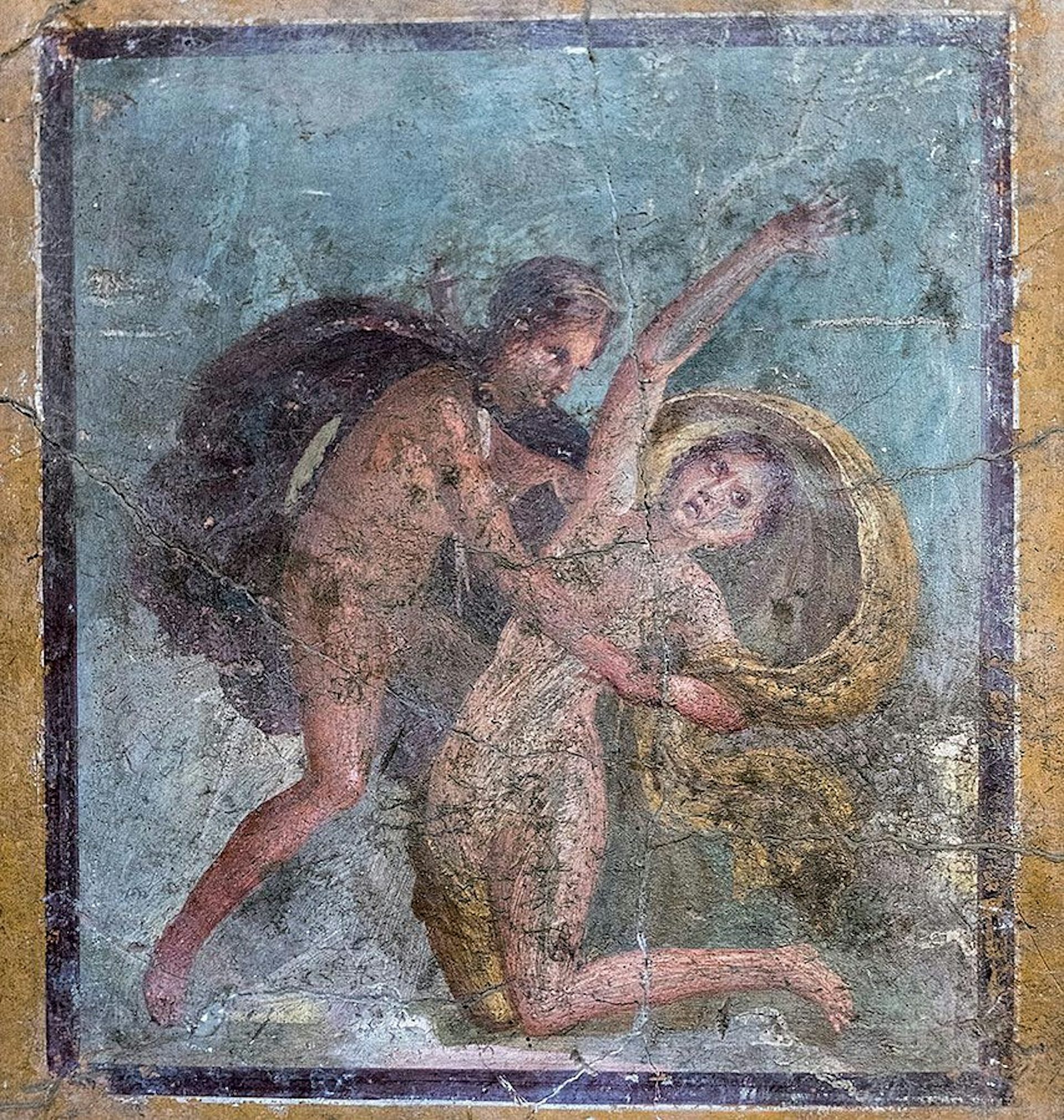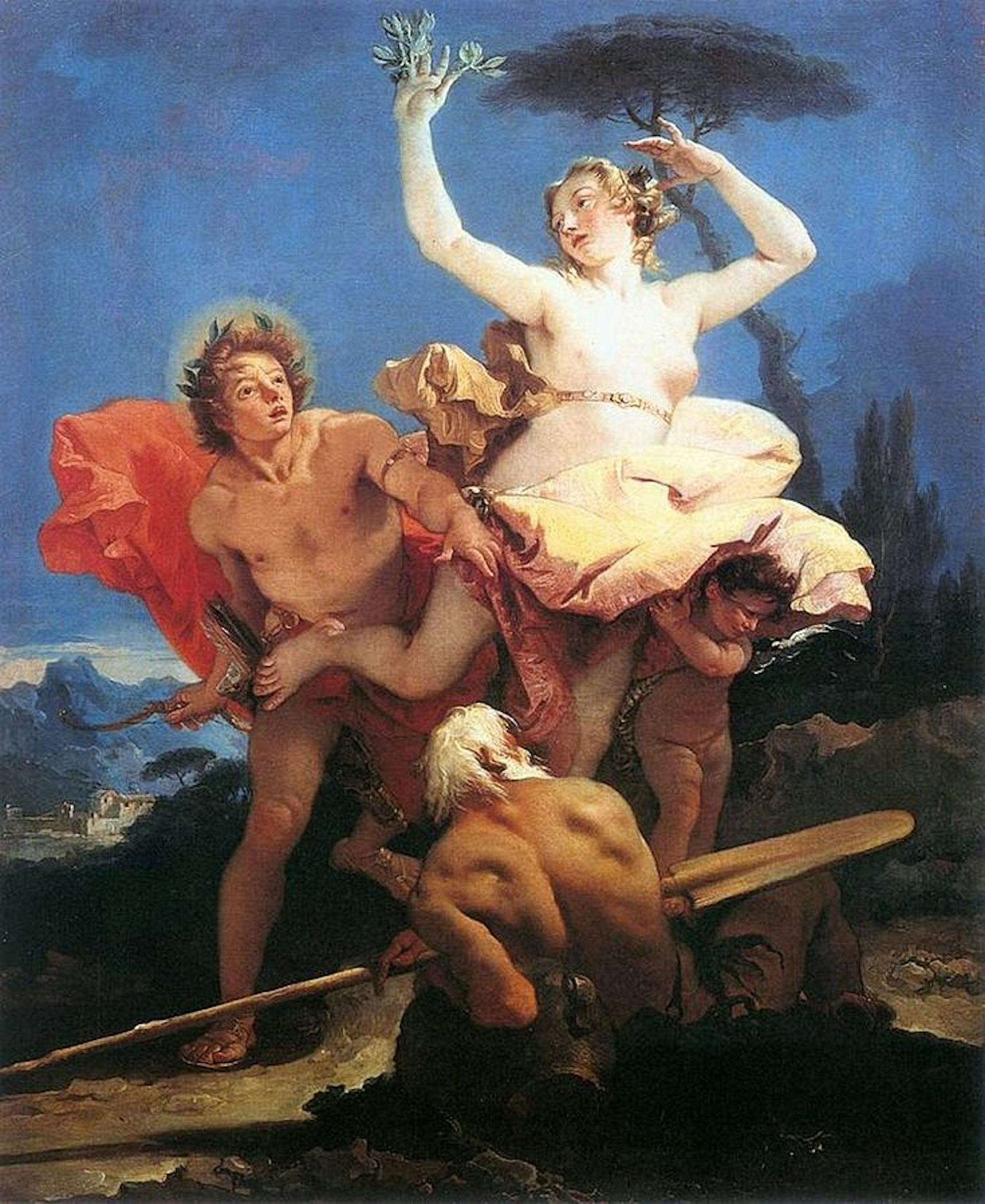Daphne

Apollo and Daphne by Gian Lorenzo Bernini (1622–1625)
Borghese Gallery, Rome / AlvesgasparCC BY-SA 4.0Overview
Daphne was a beautiful and virginal nymph, usually represented as the daughter of a river god. Numerous myths tell of how Daphne’s male admirers attempted to conquer her chastity. The most popular of these describes the god Apollo’s pursuit of Daphne, and how she transformed into a laurel tree to avoid his embrace. Though disappointed, Apollo declared that the laurel would forever be his sacred tree, with its leaves and branches used by the god’s worshippers in a number of different contexts.
Etymology
The name “Daphne” (Greek Δάφνη, translit. Dáphnē) is identical with the Greek word meaning “laurel tree”—a word that itself exists in multiple variants, including λάφνη/láphnē and δαυχμός/dauchmós. It is thought to be pre-Greek in origin.[1]
Pronunciation
English
Greek
Daphne Δάφνη (Dáphnē) Phonetic
IPA
[DAF-nee] /ˈdæf ni/
Attributes
Daphne, like most nymphs, was imagined as a beautiful young woman and was particularly famous for her chastity. Some authors claimed that she was favored by the goddess Artemis (who preferred virgins like herself), and even that Artemis blessed Daphne with superior archery skills.[2]

The "Diana of Versailles," also known as "Artemis with a Hind," Roman copy from the first or second century CE, based on a Greek original. The chaste Daphne was a devotee of the virgin goddess Artemis.
Keroen van Luin, FlickrCC BY 2.0Daphne spent her days roaming the woods and hunting. The location of her home varied according to the source: some said that she was a daughter of an Arcadian river god and thus lived in Arcadia in central Greece;[3] others that she was a daughter of a Thessalian river god and thus lived in Thessaly in northern Greece;[4] others that she was a daughter of a Spartan king and lived with him in Sparta;[5] and others, finally, connected Daphne’s dwelling place with the Orontes River and the city of Antioch, in the area between modern-day Turkey and Syria.[6]
Daphne is most famous for her transformation into a laurel tree (which, according to the myth, was named after her). Because Daphne was loved by Apollo, the laurel was considered sacred to him. Laurel branches were held by worshippers and priests of Apollo when honoring the god, and the winners of the Pythian Games—athletic and artistic contests held in Delphi in honor of Apollo—were crowned with laurel wreaths.
In ancient art, Daphne was represented as an alluring female figure. The most popular scene from her life was, of course, the moment of her metamorphosis into a tree—a subject that would eventually be taken to new artistic heights by the Italian sculptor Gian Lorenzo Bernini.[7]

Fresco from the House of Marcus Lucretius in Pompeii showing Apollo seizing Daphne as she begins to transform into a laurel tree (first century CE)
National Archaeological Museum, NaplesPublic DomainFamily
There were several different versions of Daphne’s parentage. Some said that she was the daughter of Ladon, the name of an Arcadian river and its god, or of Ladon and the primordial earth goddess Gaia.[8] Others said that Daphne was the daughter of a different river, the Peneus in Thessaly.[9] Another version made Daphne the daughter not of a river but of Amyclas, a mortal ruler of Laconia.[10]
Mythology
The daughter of a Greek river god (or a king, in some accounts), Daphne was a beautiful nymph who loved to hunt. She was very chaste and, in the fashion of virgin goddesses like Artemis, actively avoided the joys of love. However, this did not prevent her from having several male admirers.
Daphne and Leucippus
In one myth, the young Leucippus, son of the Pisan king Oenomaus, fell desperately in love with Daphne. Knowing that Daphne did not associate with men, Leucippus disguised himself as a girl and introduced himself as the daughter of Oenomaus. Leucippus soon became Daphne’s closest friend.
But the god Apollo, who also loved Daphne, grew jealous of Leucippus and plotted against him. One day, he caused Daphne and her female companions to desire to go skinny dipping in the Ladon River. Leucippus, of course, refused to undress, so Daphne and her companions stripped him by force. When they discovered that he was a man, they flew into a rage and killed him on the spot.[11]
Daphne and Apollo
The most famous of Daphne’s myths describes how the Olympian god Apollo fell in love with her and tried to seduce (or rape) her.
Ovid, whose colorful account of Daphne and Apollo in the Metamorphoses would immortalize the myth, claimed that Apollo’s unrequited love was a punishment from Eros, the god of love: Apollo had mocked the boyish Eros and the bow he used in his role as god of love, so Eros decided to teach him a lesson. He picked out two special arrows from his quiver, with two very different purposes: with one he pierced Apollo’s heart, causing him to fall in love with the fair Daphne; but the arrow that he shot at Daphne caused her to be repelled by Apollo.[12]

Apollo and Daphne by Giovanni Battista Tiepolo (1744)
Louvre Museum, ParisPublic DomainApollo tried everything to win Daphne over, but to no avail. At last, Apollo decided to take Daphne by force. Daphne fled the lustful god, and just as he was about to catch her, she prayed to the gods for aid. In response, she was transformed into a laurel tree (or, in some versions, swallowed up by the earth and replaced by a laurel tree that took her place). Ovid’s description of the metamorphosis is particularly memorable:
Before her prayer was ended, torpor seized
on all her body, and a thin bark closed
around her gentle bosom, and her hair
became as moving leaves; her arms were changed
to waving branches, and her active feet
as clinging roots were fastened to the ground—
her face was hidden with encircling leaves…[13]
But Apollo would not be stopped so easily. Though he could not have his way with Daphne, he continued to love the laurel tree. In fact, he vowed that the laurel would always be his sacred tree:
“Although thou canst not be my bride, thou shalt
be called my chosen tree, and thy green leaves,
O Laurel! shall forever crown my brows,
be wreathed around my quiver and my lyre;
the Roman heroes shall be crowned with thee,
as long processions climb the Capitol
and chanting throngs proclaim their victories;
and as a faithful warden thou shalt guard
the civic crown of oak leaves fixed between
thy branches, and before Augustan gates.
And as my youthful head is never shorn,
so, also, shalt thou ever bear thy leaves
unchanging to thy glory.”[14]
Worship
There is limited evidence for a cult of Daphne. In the city of Antioch in Syria, however, there was a sacred laurel tree that was said to have been the one substituted for Daphne when she fled from Apollo. This tree was supposedly worshipped in antiquity.[15]
Pop Culture
The myth of Daphne and Apollo remains well known in modern pop culture, due in large part to the influence of Ovid’s poetic account and Bernini’s remarkable sculpture of Daphne’s metamorphosis. Artistic adaptations of the myth have continued to this day: more recent examples include Richard Strauss’ opera Daphne (1938) and Claire Andrews’ young adult novel Daughter of Sparta (2021).